May Day Diary 2023
B. Skanthakumar
The sky is clear over Colombo on the morning of 1 May 2023. This is a relief for May Day organisers and participants alike, after days and nights of heavy rain. Along one of the routes for the many marches today, red pennants, and Buddhist flags heralding Vesak festivities later this week, flutter on alternate lamp-posts.
It feels as if we have not celebrated international workers’ day in Sri Lanka in a while. Not in year one of the COVID19 pandemic in 2020, nor its continuation as what became #EconomicCrisisLK ballooned in 2021, before last year’s social and political explosion.
In 2022, as the crippling shortage of essentials restricted mobility, there were token May Day processions and low-key indoor meetings. Some trade unions marched to the citizens’ occupation dubbed ‘GotaGoGama’, outside the office of the President by Colombo’s Galle Face promenade. Still, the mass strikes of 28 April and 06 May forcing a shutdown beyond formalised workplaces, blew wind into the sails of the Janatha Aragalaya (‘People’s Struggle’).
This year looks and feels different from the turmoil of the last. Business-as-usual for political and economic power holders; the middle-class soothed by consumerism; and most everyone else subdued and trying to get by.
Despite price hikes on food and non-food goods and services in excess of 100%, real wages across the public sector and the formal and informal private sectors dropped by an average of 20% in 2022.[i]
It is not that industrial action has been entirely absent. Public sector trade unions in the ports, petroleum, electricity, water, banks, education, and health, engaged in workplace protests over March against tax hikes and imminent privatisation, including a one-day national strike on the 15th of that month.
However, in the private sector including the plantations, and among workers and farmers in general, in neighbourhoods, and on the streets, political quietism prevails. Militancy is missing.
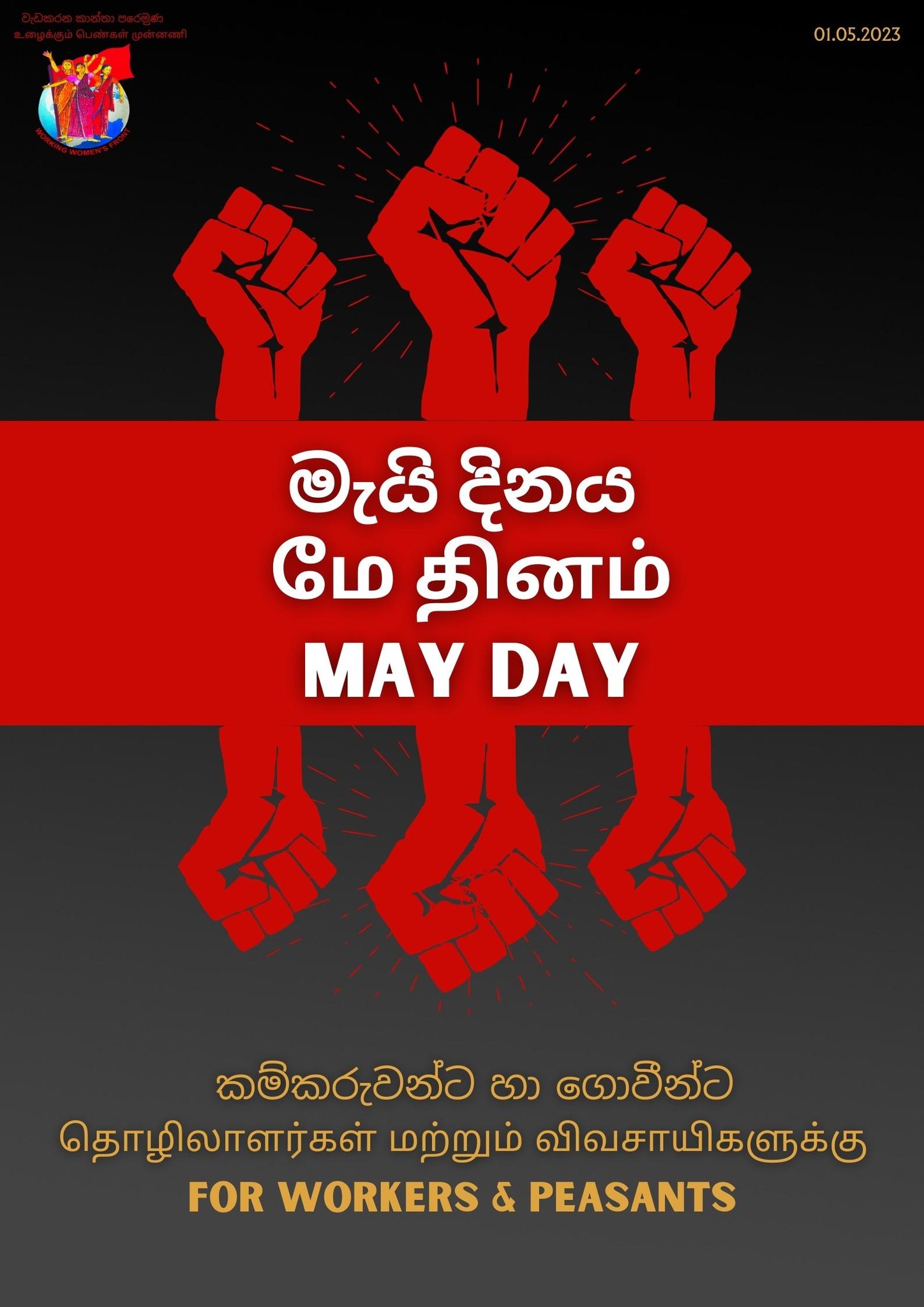
‘Arise ye workers from your slumbers’
It is 9 am and St. Michael and All Angels church in Kollupitiya – almost spitting distance from ‘Temple Trees’, the seat of presidential autocracy – is a hive of activity.
Outside the 19th century stone church, the organisers of this unique annual ‘May Day Mass’[ii], the Christian Workers Fellowship (CWF), have hung a banner: Abolish the Executive Presidency! Withdraw the Anti-Terrorism Act! It is Anti-God! Anti-People! Anti-Dhamma!
The celebration begins with a procession from the parish hall, winding through a historically poor neighbourhood of many ethnicities and faiths, on what was once a coconut estate (hence named Polwatte).
Kandyan dancers and drummers lead the way, rousing anyone still asleep. Following them are Christian clergy of different denominations draped in red stoles generously decorated with the hammer and sickle symbol. Behind the men and few women in religious habit, are the laity. One bears a heavy wooden cross against his body. One holds aloft a large red flag. To remind us whose day it is, some carry the instruments of manual workers, of tea pickers, and of small farmers.
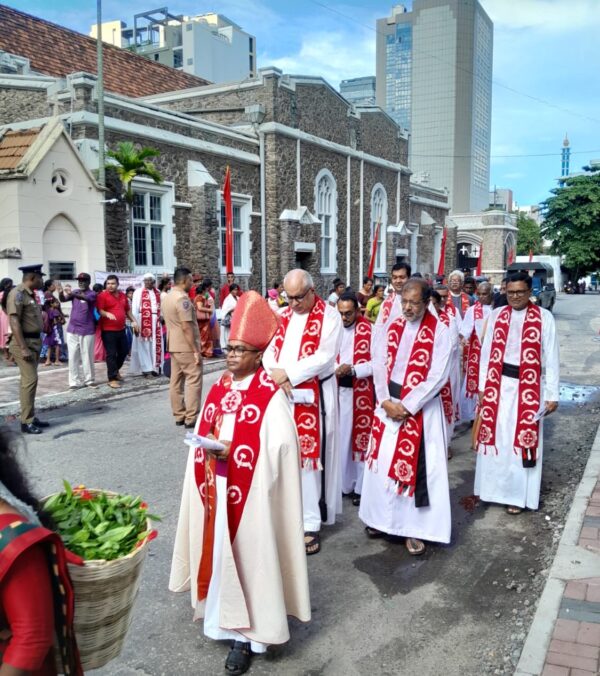
On either side of the main entrance to the church, through which the procession makes its way in, are two large cane baskets filled with green leaf. 2023 is being marked by some as the 200th anniversary of the origin of the Malaiyaha Tamil people on this island. Arriving from South India to first develop, and later work, on coffee, tea, and rubber plantations, they continue to be denied a decent and dignified life.
After several years, the church is fuller than usual, with CWF members from Anuradhapura, Kantale, Nuwara Eliya, and Vavuniya in attendance. The Anglo-Catholic tradition of St. Michael’s with its high altar, statues, incense, and candles, match the indigenised liturgy that follows: mixing religious with secular rituals, and mingling symbols of Buddhism, Christianity, and Marxism.
The (Anglican) Bishop of Kurunegala Nishantha Fernando delivers the sermon, railing against the burden of the economic crisis on the exploited and oppressed. There are bible readings, hymns, and homilies in English, Sinhalese, and Tamil. Among what is sung is the Sinhalese version of ‘The Internationale’ – Sa dukin pelena un, dan ithin nagitiyaw, anthima satanata sarasiyaw. I shall not hear it again today.
The CWF’s May Day statement is lucid, where the thinking of the Lankan Left has been muddled. The International Monetary Fund (IMF) agreement spells “… more pain for Sri Lanka’s poor and marginalised”. It is not the solution to problems whose causes cannot be reduced to foreign exchange scarcity or corrupt governance. The “real crisis” is “the result of the crisis of the world capitalist system itself”.[iii]
Their message goes on to describe the proposed legislation to replace the Prevention of Terrorism Act as a strategy by the ruling class to suppress the demand of the Aragalaya for ‘system change’. As bread and wine are shared in the Eucharist, so too should the products of industry and agriculture be for the “common good of all”; to which end, a social system with “no room for a class of exploiters” should be established.
“One for All, All for One”
It is after 11 am when I reach the premises of the Ceylon Mercantile Industrial and General Workers Union (CMU), also in Kollupitiya but by the sea. Workers are dispersing from the main hall. Without much prompting they begin arranging themselves on the narrow lane outside; now renamed after their former general-secretary, the late Bala Tampoe.
The CMU is fiercely committed to independent democratic unionism, in a milieu where the largest workers’ organisations are linked with capitalist political parties, and leaders are unaccountable to members. This stance sometimes leads it to shun joint actions. This year too. Yet its May Day statement accepts that it is necessary to “strengthen the working-class movement” and “form alliances with other trade unions and like-minded organisations”.
Like unions in general and particularly left-wing ones, it has dwindled in numbers and influence. It knows this. Top-most among its themes this May Day is Rebuild the CMU: “We have to urgently organise ourselves first at the branch level in order to effectively bargain for better terms and conditions of employment”.[iv]
Unlike most other rallies today which are extensions of political or electoral campaigns, the CMU demands a minimum wage that is also a living wage; defence of the living standards of working people; withdrawal of the Anti-Terrorism Bill; and opposition to the suppression of workers’ rights, including proposed labour law reforms. It calls on workers to resist the burden of the sovereign debt crisis being passed onto them, through “IMF-imposed austerity measures”.
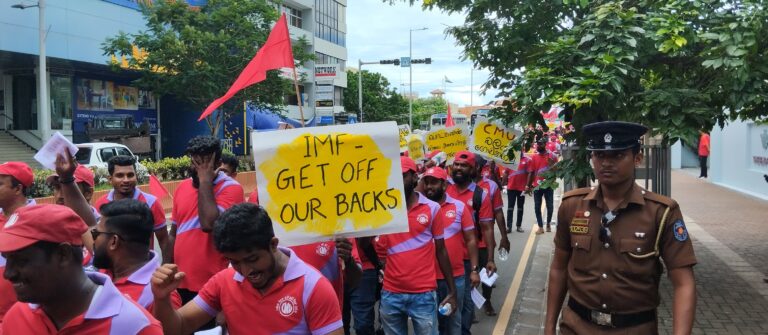
The march begins. Many hundreds in red t-shirts and caps with the CMU logo and its motto “One for All, All for One”, and sometimes the name of their branch, waving red flags, take to the main road towards Galle Face Green. Most are younger than I expected, and there are women among them. One of their chants in Sinhalese borrows from last year’s protests: “Who has the Power?” The modified reply is, “The CMU has the Power!”
The placards in all three languages raise the threat to retirement (Employees Provident and Trust Funds) savings from domestic debt restructuring; demand price controls, and the right to protest; and protest that the “IMF get off our backs”.
Near the grand colonial-era hotel facing the Green, the police have nervously blocked forward passage. Instructions have been passed to prevent public protest in the vicinity of the Presidential Secretariat. All memory of last year’s mass action must be erased.
In any case, there is no such intention, and the demonstrators circle the roundabout. They head south, up to near ‘Temple Trees’, before turning by an abandoned luxury hotel development, to disperse at the CMU office.
Public Performances
The political parties that have driven us to disaster over the past 75 years have their own public performances today, which will be telecast in the evening news bulletins.
The first of May has been an official holiday in Sri Lanka since 1956. This was a coming to terms with the tradition of unofficial May Days, as Eric Hobsbawm observed of Western Europe; which in British Ceylon were spearheaded by pioneer trade unionist A. E. Goonesinha beginning in 1927.
This institutionalisation or co-option of May Day by government, says Hobsbawm, recognised the need “to detach it from labour movements, class consciousness and class struggle”.[v] This rings true here too.
Since the 1960s, the largest demonstrations on May Day have been of parties in government, earlier of the Left and later of the Right. While national, sectoral, and branch-level leaders of affiliated unions participate; many are voters and clients mobilised by elected representatives and local political organisers,[vi] and those available for a free outing to Colombo, with music and dance shows packaged for mass entertainment.
The United National Party (UNP) has a morning rally at the Sugathadasa indoor stadium, minus a demonstration. Re-energised by the accidental ascent of its leader-for-life to the presidency – though Ranil Wickremesinghe is inexplicably absent, addressing the faithful in a pre-recorded video message – the venue which seats around 5,000 is full, according to television visuals.
The Minister for Labour and Foreign Employment presents his 11 proposals for the “security of human resources in the future” including unification – and deregulatory reform – of labour laws. As is convention, the resolution is unanimously carried. Some turkeys do vote for Christmas.
In the afternoon, the Sri Lanka Podujana Peramuna (SLPP—People’s Front) musters a few tens of thousands at Campbell Park in Borella, if media reports are reliable. Prime Minister Dinesh Gunawardena is on the stage to underline his allegiance to the Rajapaksa family. Their theme is Let’s defeat challenges and realise aspirations.
Among those challenges is to distance itself from the record in office of its presidential candidate Gotabaya Rajapaksa, all reference to whom is now expunged. The star turn is of course Mahinda Rajapaksa. His challenge is to defeat mortality long enough for his firstborn to enjoy the spoils of the highest office of the land. There are others with aspirations too. Basil Rajapaksa does not speak but uses the rally to build his brand: covetous as he is to someday be coronated president himself.
The Samagi Jana Balawegaya (SJB—United People’s Power) unlike its parent UNP has decided to conduct a procession, ending with a rally at the A. E. Gunasinghe (sic) ground in Pettah. Their gathering in the low tens of thousands with green caps, banners and flags, begins from the P. D. Sirisena ground surrounded by the tenements of Maligawatta. Many of the faces in this crowd look nothing like waged workers, ranging instead from landed proprietors to businesspeople to middle-class professionals, but also the urban and rural indigent.
As with the UNP and SLPP events, the objective is to boost the image of its leader and putative presidential candidate in 2024. Sajith Premadasa declares that his party while not anti-IMF, would have been a stronger negotiator than the current government, and not agreed to divestment of State assets. In fact, the difference between his economic ‘dream team’ and Ranil Wickremesinghe, is as slight as the peel of a clove of garlic.
Unity of Working People
As I reach Olcott Mawatha in Pettah for another leftist event, it is past 1 pm. What is of significance in this ‘United Working People’s May Day’, is an all too rare and fragile example of unity in action across private, semi-State, and public sector trade unions (and beyond the populous Western Province); along with informal sector workers; and organisations of small farmers and fishers.
Those present here strongly identified with the 2022 Aragalaya. Some among them were arrested and imprisoned. Activists who were familiar faces at ‘GotaGoGama’ have come along in solidarity. It is their first experience of a May Day with workers and their organisations.
The front of the procession has already left Fort railway station. It comprises women and men workers in export factories organised by the Free Trade Zone and General Services Employees Union (FTZGSEU), and its sister organisation the Women’s Centre – which this year in coordination with other women’s groups has conducted a May Day demonstration in the southern city of Galle.
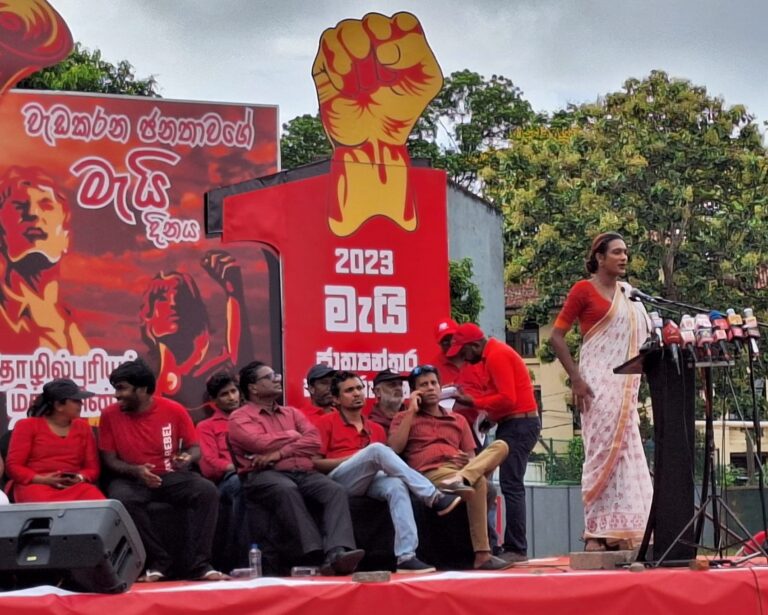
Others who follow include the Movement for Malaiyaha People’s Land Rights representing tea plantation workers; workers organisations in the garment industry that have recently registered themselves as trade unions such as the Dabindu Collective and Stand-Up Movement, along with the women-led Textile, Garment and Clothing Workers Union; the National Union of Seafarers; the non-traditional PROTECT union that organises domestic and other informal workers in Colombo and Hatton; the National Fisheries Solidarity Movement (NAFSO); and the Movement for Land and Agricultural Reform (MONLAR), that is affiliated with the international movement in defence of peasant agriculture and for food sovereignty, La Via Campesina (‘The Peasants Way’).
There are sizeable delegations from the Ceylon Teachers Union (CTU); the Union of Postal and Telecommunications Officers (UPTO); and the Ceylon Bank Employees Union (CBEU), that shouldered much of the logistical burden for this unitary initiative which was promoted by the United Federation of Labour (UFL).
The procession reaches the P. D. Sirisena ground around 3 pm, after being halted by the police at the Maradana Technical College junction, to allow the SJB procession to clear the area. While numbers are in the low thousands, the sheer diversity, and assertion of trade unionism independent of pro-capitalist parties and for working class politics, is encouraging.
On the platform of speakers in addition to the usual cast of men, there are five women. Far too few in proportion to the number of men. But more than will address other rallies today, including of Left parties. Among them is Bhoomi Harendran who informs participants of a new National Union for Transgenders and their delight in partaking in this May Day action.
The statement delivered in Sinhalese and Tamil, recalls that working people are not responsible for the multiple crises created by the neoliberal, racist, and bigoted policies of the ruling class over many decades.
Yet these costs are transferred to the exploited and oppressed: “… food inflation rising over 90%, inflation rising over 70%, electricity tariffs rising by 200%, transport cost tripling, kerosene prices quadrupling, interest rates almost tripling and real wages falling by 40%.”[vii]
Their declaration called for redistributive justice through increased wages and wealth taxes; opposition to anti-terror laws; for the abolition of the Executive Presidency; devolution of power to the regions; and democratisation of the State.
“On this May Day”, it concluded, “we the working people of Sri Lanka march together and in solidarity with working people across the world for a just future. We march for an economic system that does not steal the wealth of working people to enrich those who do not labour to produce the wealth. We march for our resources and wealth to be equitably and sustainably used and shared amongst us and for future generations.”
The speeches are not over, and I shall miss rock musician Ajith Kumarasiri rasping his stinging lyrics on the political establishment, but the sky is beginning to cloud and there is a final stop on my itinerary today.
‘Red May Day’
A show of strength is expected from the Janatha Vimukthi Peramuna (JVP—People’s Liberation Front) today. And it is so.
The JVP’s ‘Red May Day’ sets off around 2 pm from the Burgher Recreation Club (BRC) ground in Havelock Town, to march four kilometres to its rally on F. R. Senanayake Mawatha, between the Colombo Municipal Corporation building and the Viharamahadevi Park.
At the head of the parade, four gleaming black double-cabs carry giant portraits of Karl Marx, Friedrich Engels, Vladimir Lenin, and JVP founder Rohana Wijeweera, in that sequence. The colour of the shirts and caps, and flags emblazoned with the hammer and sickle, make the route a roving sea of red.[viii]
Members of the public sector National Trade Union Centre (NTUC) and private sector Inter-Company Employees Union (ICEU) are in evidence. There are placards in Sinhalese, Tamil, and English, protesting the tax hikes, the robbery of workers’ retirement savings, the privatisation of public assets, IMF austerity, and attacks on democratic rights including the draft Anti-Terrorism Act.
There are many others neither wearing red nor with the manner of JVP cadre. They are former loyalists of the SLPP, disenchanted over the past couple of years by the Rajapaksas and traditional political parties, and currently supportive of the JVP’s electoral front, the Jathika Jana Balawegaya (JJB—National People’s Power).
The Socialist Youth Union (SYU) has a marching band and mobile sound system to entertain the crowd. There are bagpipes players, in addition to the usual drums and accordions, participating as the Society for Socialist Arts.
After 4 pm when I squeeze my way to near the front of the massive stage on which JVP leaders and their allies are seated, the tail end of the march is still leaving the BRC. Later, the JVP claim an attendance of 90,000. Even if that number is exaggerated, it is the largest gathering of the day.
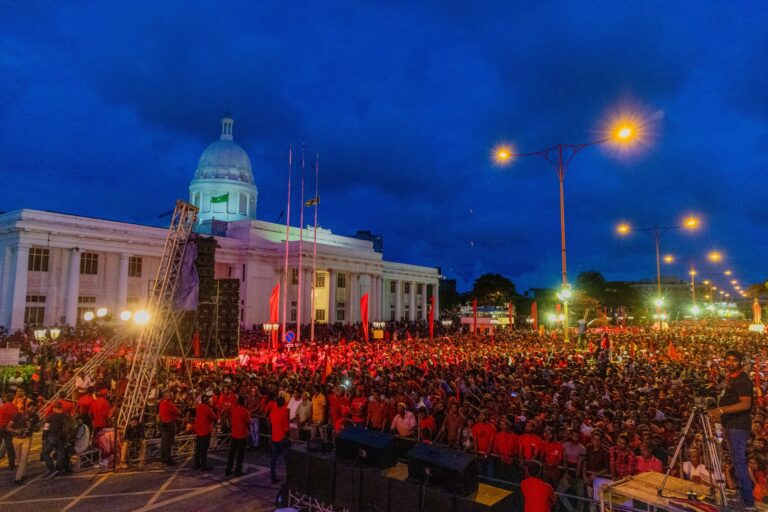
Apparent in this event too is how the JVP faces two ways. As a party with its origins within the Ceylon Communist Party in the 1960s, its iconography resembles State socialism, and its official declaration is critical of capitalism.
The condition of Sri Lanka after 75 years of mis-rule is “a social, economic and political tragedy”. The crisis in which we are mired is symptomatic of global capitalism, and cannot be answered except by “… significant changes in the socio-economic structure. It calls for a social transformation”.
Yet, as a party with aspirations to form a ‘people’s government’ through the ballot box, its public discourse including this May Day, while occasionally invoking the peeditha janathawa (oppressed people), speaks beyond them.
The emphasis is on corruption, fraud, and waste, which is a popular theme with socially conservative as well as popular classes; as is its promise to hold the Rajapaksas and their cronies accountable for economic devastation.
The careful references in its May Day communique to a “productive economic system” and “social justice” are intended not to scare the professional and other sections of the middle-class whom the JVP courts through the JJB/NPP.
Anura Kumara Dissanayake speaking in Sinhalese informs the rally that it has achieved the JVP’s highest turnout yet of Tamils and Muslims from the Northern, Eastern, and Hill Country regions. One section of his speech is interpreted in parallel into Tamil. It makes a direct appeal to minorities for their support, without reference to their claims for reconstitution of the state and power-sharing.
He says the JVP understands their suffering and pain, making specific mention of the continuous campaign of families of the disappeared in the North and East for truth and justice; the marginalisation of those on the plantations; and betrayals by parliamentarians of Muslim political parties of their community’s best interests.
The message from the JVP’s May Day stage is consistent with what it says on the platform of the JJB/NPP: early elections are what is needed, and what it badly wants. The JVP believes it can capitalise on broad discontent to boost its representation in elected institutions, paving its path to power through peaceful means, after two failed armed revolts.
When Better Days Dawn
The four events which I viewed from the crowd – there were of course others that I could not attend – were spirited. Yet, it was hard to detect significant residue from 2022’s uprising in their organising and politics.
‘System change’ was among the demands last year of young people particularly. But the slogans of left trade unions before and since remain defensive of the status quo. They rightly resist the relentless assault and battery of neoliberalism. But where is our May Day Manifesto? Have we gauged humanity’s poly-crisis? Are we resigned to serial short-term issue-based campaigns? Will we find the connections between our causes? Does our praxis signal surrender to this ruinous political, economic, and social system?
May Day 2023 passed with neither bad weather nor skirmishes with State security. Colombo was quiet as offices and schools were closed, and many stores shuttered. Still, it was not a day for rest or protest for all who farm and fish, toil in homes and in the care economy, and on building sites and in daily-waged work. That awaits when “better days dawn, when the working class of the world has won its deliverance”.[ix]
B. Skanthakumar is with the Social Scientists’ Association (SSA) of Sri Lanka; and author of “Labour’s lost agency” in ‘Labour and its Discontents’, Himal Southasian (Kathmandu), 28(1) (March 2015): 12-34.
Image Source: https://bit.ly/3qOkQIY
Notes
[i] Central Bank of Sri Lanka. (2023). Annual Report 2022 (Volume 1). Colombo: Central Bank of Sri Lanka, p. 143. Available at https://www.cbsl.gov.lk/sites/default/files/cbslweb_documents/publications/annual_report/2022/en/14_Infographics_04.pdf
[ii] Vidyasagara, Vijaya. (2016). Memoirs of a Christian and a Socialist. Balasingham Skanthakumar and Marshal Fernando (Eds.) (141-149). Colombo: Ecumenical Institute for Study and Dialogue.
[iii] Christian Workers Fellowship. (2023). “Abolish the Executive Presidency! Withdraw the Anti-Terrorism Act! It is Anti-God! Anti-People! Anti-Dhamma!”, Europe Solidaire San Frontières (Paris) (01 May). Available at https://www.europe-solidaire.org/spip.php?article66514
[iv] Daily FT. (2023). “Ceylon Mercantile, Industrial and General Workers Union celebrates May Day”. (02 May). Available at https://www.ft.lk/news/Ceylon-Mercantile-Industrial-and-General-Workers-Union-celebrates-May-Day/56-747878
[v] Hobsbawm, Eric. (1998[1990]). “Birth of a Holiday: the First of May”. In Uncommon People: Resistance, Rebellion and Jazz (113-127). London: Weidenfeld & Nicolson, p. 114. Available at https://tribunemag.co.uk/2019/05/the-history-of-may-day
[vi] Kotelawala, Himal. (2017). “The Farce That Is The May Day”. roarmedia.lk (01 May). Available at https://roar.media/english/life/reports/the-farce-that-is-the-may-day
[vii] Collective. (2023). “Sri Lanka: Working People Unite Against Economic and Political Oppression”, Europe Solidaire San Frontières (Paris) (01 May). Available at https://www.europe-solidaire.org/spip.php?article66537
[viii] Here is Jayadeva Uyangoda’s description of a similar scene in 1982: “The JVP May Day procession left the Havelock Park at 11.00 a. m. and when the tail end entered the Town Hall grounds it was past 7.00 in the evening. Regiments of young men and women in military uniform (without carrying fire arms, of course), motorcyclists bearing children with beautifully arranged bouquets of flowers held high, muppets, dance and song troups (sic) including street drama groups, pandals and a sea of red flags and banners were among the crowd-pleasing contingents of a very well-organised demonstration of over 30,000”, See “May Day Reports: A view from the crowd”, Lanka Guardian (Colombo), Vol. 5, No. 2 (May 15, 1982: 03-05), p. 03. On that May Day too, the JVP’s emphasis was electoral (the presidential poll of October 1982 and parliamentary election due in 1983). Then on 30 July 1983, the JVP was proscribed by the UNP regime, and driven underground, leading to its second bloody insurrection between 1987 and 1989.
[ix] Luxemburg, Rosa. (1971[1894]). “What Are the Origins of May Day?” In Dick Howard (Ed. and Trans.). Selected Political Writings of Rosa Luxemburg (315-316). New York: Monthly Review Press, p. 316. Available at https://www.marxists.org/archive/luxemburg/1894/02/may-day.html
